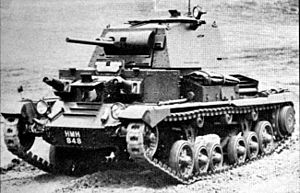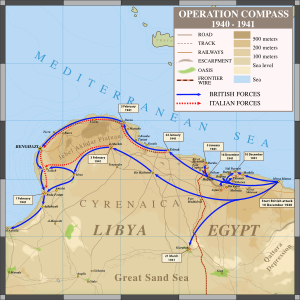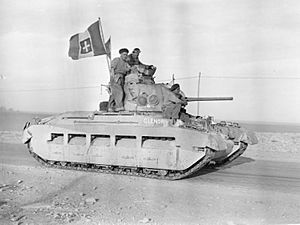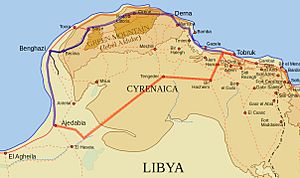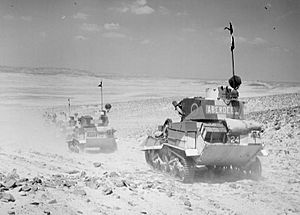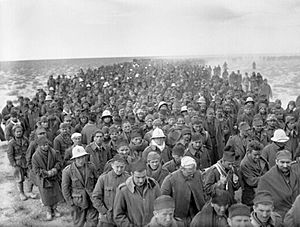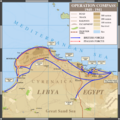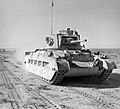Operation Compass facts for kids
Quick facts for kids Operation Compass |
|||||||||
|---|---|---|---|---|---|---|---|---|---|
| Part of The Western Desert Campaign of the Second World War | |||||||||
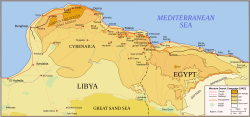 Map showing the Western Desert theatre |
|||||||||
|
|||||||||
| Belligerents | |||||||||
|
|
|||||||||
| Commanders and leaders | |||||||||
|
|
||||||||
| Strength | |||||||||
| 36,000 men 275 tanks 120 guns 142 aircraft |
150,000 men 600 armoured vehicles 1,600 guns 331 aircraft |
||||||||
| Casualties and losses | |||||||||
| 500 killed 1,373 wounded 55 missing 26 aircraft |
5,500+ killed 10,000 wounded 133,298 captured 420 tanks 845 guns 564 aircraft (incl. reinforcements) |
||||||||
Operation Compass was the first big military operation by British forces during the Second World War. It was part of the Western Desert Campaign in North Africa. From December 1940 to February 1941, British, Commonwealth, and Empire soldiers attacked Italian forces in western Egypt and Cyrenaica, which is the eastern part of Libya.
The Western Desert Force (WDF), led by Lieutenant-General Richard O'Connor, had about 36,000 men. They launched a surprise attack from Mersa Matruh in Egypt. Their target was the Italian 10th Army, which had about 150,000 soldiers spread out in strongholds around Sidi Barrani in Egypt and in Cyrenaica. The WDF quickly defeated the Italians in their fortified positions and at Sidi Barrani. They then pushed the rest of the 10th Army out of Egypt and captured ports along the Libyan coast. The Italian 10th Army was cut off as it tried to retreat and was defeated at the Battle of Beda Fomm. The remaining Italian soldiers were chased all the way to El Agheila.
The British captured over 138,000 Italian and Libyan prisoners, hundreds of tanks, and more than 1,000 guns and many aircraft. The WDF lost about 1,900 men killed and wounded. The WDF could not go beyond El Agheila because their vehicles were worn out. Also, in March 1941, their best units were sent to Greece for another battle. Italy quickly sent more soldiers to Libya to protect Tripoli. They were also helped by German forces, including the famous Afrika Korps.
Contents
Background to the Battle
Italian Forces in North Africa
When World War II started, Italy had two main armies in Libya. The 5th Army was in western Libya, and the 10th Army was in eastern Libya (Cyrenaica). After France was no longer a threat, some units from the 5th Army moved to help the 10th Army. Marshal Rodolfo Graziani became the new leader of Italian forces in Libya. He worried that his large army, which mostly walked, might not beat the British, who had fewer soldiers but had many vehicles.
After getting more troops, the 10th Army had about 150,000 infantry soldiers, 1,600 guns, 600 small tanks (tankettes) and tanks, and 331 aircraft. One important unit was the Maletti Group. It was made up of motorised infantry, tanks, and artillery. This group was the main mobile unit for the 10th Army.
British Forces in North Africa
The Middle East Command, led by General Archibald Wavell, had about 36,000 soldiers, 120 guns, and 275 tanks. The Royal Air Force (RAF) had 142 aircraft, including Hurricanes and Bristol Blenheims.
The main British fighting force was the Western Desert Force (WDF), commanded by Lieutenant-General Richard O'Connor. It included the 4th Indian Infantry Division and the 7th Armoured Division. Later, the 6th Australian Infantry Division joined them. The British had fast Cruiser Mk I, Cruiser Mk II, and Cruiser Mk III tanks. These tanks had powerful 2-pounder guns, which were better than the Italian Fiat M11/39 tanks. The British also had Matilda II infantry tanks. These tanks were slow, but their armor was so strong that Italian anti-tank guns could not break through it.
Early Skirmishes
Italy declared war on Britain and France on 10 June 1940. For the next few months, there were small battles and raids between Italian forces in Libya and British forces in Egypt. For example, on 12 June 1940, British warships attacked Tobruk, an important port. RAF bombers also attacked Italian airfields.
Planning the Attack
Italian Advance into Egypt
On 13 September 1940, the Italian 10th Army moved into Egypt. This was called Operazione E. As the Italians advanced, a small British force at Sollum pulled back to a stronger defensive position. The British kept bothering the Italian advance with small attacks. The Italians moved about 95 kilometers (59 miles) in three days. On 16 September, they stopped at Maktila, 16 kilometers (10 miles) past Sidi Barrani.
The Italians then dug in and built five strong camps around Sidi Barrani. They waited for more supplies and soldiers to arrive. These camps were at Maktila, Tummar East, Tummar West, Nibeiwa, and Sofafi.
The British Plan for Compass
After the Italian advance, General Wavell told Lieutenant-General Sir Henry Maitland Wilson to plan a limited attack to push the Italians back. This attack was called Operation Compass. It was first planned as a five-day raid, but they also thought about continuing it if it went well.
The British plan was to surprise the Italians. The 7th Support Group would watch the Italian camps at Sofafi. Meanwhile, the main British forces would sneak through a gap between Sofafi and Nibeiwa. An Indian brigade and Matilda tanks would attack Nibeiwa from the west. After Nibeiwa was captured, another Indian brigade and the tanks would attack the Tummar camps. A special force called Selby Force would keep the Italian camp at Maktila busy. The Royal Navy would also fire shells at Maktila and Sidi Barrani from the sea.
The preparations were kept very secret. Soldiers only learned the real plan on 7 December, just before the attack. On 8 December, an Italian plane saw that an attack was coming, but the Italian commander at Nibeiwa was not told.
Operation Compass began on the night of 7/8 December. The Western Desert Force moved 113 kilometers (70 miles) to their starting positions. The RAF attacked Italian airfields, destroying or damaging 29 aircraft. Selby Force moved into position near Maktila. British warships also bombarded Maktila and Sidi Barrani.
Battle of the Camps
Nibeiwa Attack

At 5:00 a.m. on 9 December, British artillery started firing at the Italian camp at Nibeiwa to distract them. At 7:15 a.m., the main artillery bombardment began. The 11th Indian Infantry Brigade, with Matilda tanks, attacked Nibeiwa from the north-west, which was the weakest part of the defenses.
By 8:30 a.m., Nibeiwa was captured. The Italian commander, Maletti, was killed. The Italians lost 818 men killed, 1,338 wounded, and 2,000 soldiers were taken prisoner. The British captured a lot of supplies. The British had only 56 casualties.
Fighting at The Tummars
The attack on Tummar West started at 1:50 p.m. after the tanks refueled. British tanks broke through the defenses, followed by infantry. The Italian defenders fought hard, but by 4:00 p.m., Tummar West was mostly captured. The tanks then moved to Tummar East, which was also captured by nightfall. The 2nd Libyan Division lost many soldiers: 26 officers and 1,327 men were killed, and 32 officers and 804 men were wounded. The rest were taken prisoner.
Maktila and Sidi Barrani
The 1st Libyan Division at Maktila tried to escape, but Selby Force chased them. British tanks arrived and trapped the Italians in the sand dunes. The Italians were caught in a small area near the sea at Sidi Barrani. When the British attacked again on 11 December, many Italians surrendered.
On 10 December, the 16th Infantry Brigade attacked Sidi Barrani. With help from artillery and tanks, they surrounded the town. The British attacked at 4:00 p.m., and the town fell by nightfall. The remaining Italian soldiers were trapped. On 11 December, more Italians surrendered. The 63rd Infantry Division "Cirene" also pulled back from Sofafi, escaping the British. In total, the Italians lost 2,184 men killed, 2,287 wounded, and 38,000 prisoners in these battles.
Pushing Forward
Over the next few days, the British tried to chase the Italians. However, they had problems getting supplies and had to deal with a huge number of prisoners, which slowed them down. British warships continued to bombard Italian positions along the coast. By late 12 December, the only Italian positions left in Egypt were near Sollum.
The Italians had lost 38,289 soldiers (mostly prisoners), 73 tanks, and 237 guns. The British had only 634 casualties. The WDF paused to get organized, then quickly moved west into Libya, through Halfaya Pass, and recaptured Fort Capuzzo. British bombers also continued to attack Italian air bases.
The Chase Continues
Sollum, Halfaya, and Fort Capuzzo
The British continued their pursuit. By 15 December, Sollum and the Halfaya Pass were captured. Fort Capuzzo, about 40 kilometers (25 miles) inland, was also taken. The 7th Armoured Division then waited near Bardia for the 6th Australian Division to arrive. By this point, the WDF had taken 38,300 prisoners, 237 guns, and 73 tanks. Their own losses were 133 killed, 387 wounded, and eight missing.
Battle for Bardia
The 6th Australian Division, led by Major General Iven Mackay, attacked the Italian forces at Bardia from 3 to 5 January 1941. They had help from air support, naval gunfire, and artillery. The Australians attacked from the west, where the defenses were weak. Engineers blew up barbed wire and filled in anti-tank ditches.
The Australian infantry and 23 Matilda tanks broke through the Italian defenses and captured 8,000 prisoners. The Australians continued to push forward, cutting the fortress in two. Thousands more prisoners were taken. On the third day, the remaining Italian soldiers surrendered. About 25,000 prisoners were taken, along with 400 guns, 130 tanks, and hundreds of vehicles. The Italians also had 1,703 killed and 3,740 wounded.
Capture of Tobruk
After Bardia, the British and Australian forces moved on to Tobruk, another important port city. They attacked Tobruk on 21 January 1941. The Australians again used their Matilda tanks to break through the defenses. The battle lasted for a day, and Tobruk was captured on 22 January. This was another big victory for the British, as they took many more prisoners and captured a lot of equipment.
Derna and Mechili
East of the Jebel Akhdar mountains, the Italian XX Corps was defending the area. They had about 120 tanks, including 82 new M.13/40 tanks. On 23 January, the Italian commander ordered a counter-attack. The next day, Italian tanks attacked the British, but the British fought back and destroyed several Italian tanks.
To the north, Australian soldiers fought the Italian Sabratha Division near Derna airfield. The fighting was tough, but the Australians slowly gained ground. On 26 January, the Australians cut the Derna–Mechili road. The Italians pulled back on the night of 28/29 January to avoid being trapped. They tried to slow the British by blowing up roads and setting up traps. Derna was captured without a fight on 29 January.
Battle of Beda Fomm
In late January, the British learned that the Italians were retreating along the main coastal road from Benghazi. The 7th Armoured Division was sent to cut them off by moving through the desert, south of the Green Mountain. The 6th Australian Division chased the Italians along the coast road.
The desert slowed the British tanks, so a fast group of wheeled vehicles, called Combe Force, was sent ahead. Late on 5 February, Combe Force reached the coastal road south of Benghazi and set up roadblocks. The leading Italian forces arrived just 30 minutes later. The Italians attacked to try and break through the roadblock, continuing their attacks into 7 February. But with more British soldiers arriving and the Australians pushing from Benghazi, the rest of the Italian 10th Army surrendered. From Benghazi to Agedabia, the British took 25,000 prisoners, 107 tanks, and 93 guns.
Desert Operations
Giarabub, Kufra, and Uweinat
Italian soldiers also held other remote desert outposts. Giarabub, 150 kilometers (93 miles) south of Sollum, was attacked in January 1941 and captured in March by Australian forces. Further south, the Kufra Oasis was attacked by Free French forces and British Long Range Desert Group (LRDG) patrols. Kufra was captured in March 1941.
Even further west, near the border with Chad, the Italian base at Murzuk was raided in January. A small group of British and Free French soldiers traveled 1,300 kilometers (808 miles) to attack Murzuk. They destroyed aircraft and hangars. The raiders then attacked three forts before leaving.
At Jebel Uweinat, a mountain 600 kilometers (373 miles) inland, there was an Italian base. British patrols visited the area and met with French forces for a planned attack on Kufra. The British were attacked by Italian armored cars, which destroyed several trucks. The British returned to Cairo after a 45-day journey. Kufra was captured by the French on 1 March and became a new LRDG base.
Aftermath of Operation Compass
Losses
The Western Desert Force had 500 soldiers killed, 55 missing, and 1,373 wounded. The RAF lost 26 aircraft. Many more aircraft were damaged and couldn't be used because of a lack of spare parts.
The Italian 10th Army lost at least 5,500 men killed, about 10,000 wounded, and 133,298 men were taken prisoner. They also lost 420 tanks and 845 guns.
What Happened Next
A week after the Italian surrender at Beda Fomm, leaders in London decided that the British should hold Cyrenaica with as few soldiers as possible. The extra troops were to be sent to Greece. The 7th Armoured Division, which had been fighting for eight months, was very worn out and needed to be repaired.
The 6th Australian Division went to Greece in March. Other British and Australian units were left in Cyrenaica. It was thought that the Italians would not be able to attack again until May, even with German help.
A few thousand Italian soldiers escaped the defeat in Cyrenaica. The Italian 5th Army in western Libya still had four divisions. Strongholds were reinforced with troops from Italy, bringing the Italian armies up to about 150,000 men. German reinforcements, the first units of the Afrika Korps led by General Erwin Rommel, were sent to Libya. On 25 March 1941, General Graziani was replaced by General Gariboldi as the Italian commander.
Images for kids
-
A Matilda tank of the 7th Royal Tank Regiment in the Western Desert.



